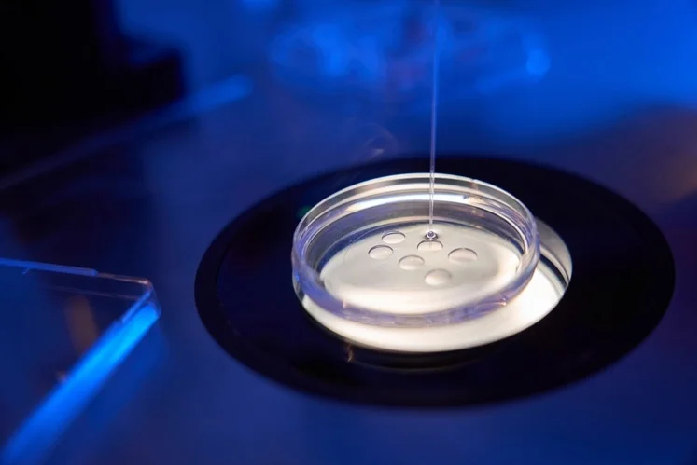The acquisition of the oocyte developmental competence process is crucial to establishing a viable method that allows an oocyte to be fertilized and supports the early stages of embryonic development.1,2 Abnormalities that occur during folliculogenesis are an underlying cause of infertility and can fail assisted reproductive technologies (ART) such as in vitro fertilization (IVF) and intracytoplasmic sperm injection (ICSI).1,3

Image Credit: Svitlana Hulko/Shutterstock.com
The World Health Organization estimates that one in six couples are affected by infertility.4 Even with the progress achieved with ARTs in recent years, infertility treatment falls short of its desired impact, with a rate of pregnancy per retrieved oocyte during IVF of just 4.5 %.5 Gaining a deeper understanding of the processes that enable the formation of a high-quality oocyte would bring about improvements in ART.5
One characteristic of oocyte development and physiology that has remained a mystery for 60 years is the elevated presence of cytoplasmic lattices within the cytoplasm of mammalian oocytes. First observed using electron microscopy in the 1960s, scientists could not agree on their function.3 More recently, they were believed to be structures that store chains of ribosomes, similar to a string of beads.2,3,6
Several oocyte-specific proteins are key to forming cytoplasmic lattices, specifically peptidylarginine deaminase (PADI6) and the subcortical maternal complex (SCMC). In humans and mice, arrested embryonic development was observed where gene mutations occurred in these proteins.3
Researchers at the Max Planck Institute for Multidisciplinary Sciences in Göttingen, Germany, have been studying the function and structure of the cytoplasmic lattice as well as its relationship to PADI6 and SCMC.3
Discovering the 3D Organization of Cytoplasmic Lattices
The researchers first evaluated the localization of PADI6 and SCMC proteins within oocytes. Utilizing the HaloTag labeling method and leveraging the power of super-resolution microscopy, they determined that PADI6 and SCMC proteins are distributed throughout the cytoplasm at different stages of meiosis and early embryo development.3
Further analyses were centered on the three-dimensional structure of PADI6 and SCMC, which revealed that the proteins were densely packed into fibers measuring around 100 nm wide and, on average, 700 nm long. These observations demonstrated that the fibers were the cytoplasmic lattice, which, in effect, confirms that cytoplasmic lattices are, by definition, fibers dense in PADI6 and SCMC.3
The researchers used room-temperature electron tomography (RT-ET) to detect the 3D organization of cytoplasmic lattices, while they leveraged cryo-electron tomography (cryo-ET) for the in-situ visualization of cellular complexes.
In the RT-ET samples of mouse oocytes, the team determined individual filaments across the lattice fibers, recording their helical arrangement. Statistical analysis found that the filaments are approximately 200 nm long. An average of 22 filaments was detected within a fiber cross-section.
Cryo-ET verified the helical nature of these fibers, revealing multiple stacked filaments. The stiffness of these filaments is similar to that of amyloid fibrils and microtubules, as indicated by the application of persistence length analysis. This underscores their structural robustness. Overall, the study offers an in-depth look at cytoplasmic lattice filaments' organization and mechanical properties.
The cytoplasmic lattice assembly depends on the presence of PADI6 and SCMC proteins, which may serve as essential elements of the filaments.
A Protein Storage Structure
The study, published in Cell, indicates the importance of cytoplasmic lattices storing proteins for embryonic development. The researchers describe how these proteins act as a stockpile that allows the egg to supply the embryo with what it needs during the initial stages of embryonic development.
The compartmentalization of the proteins to the lattice may also serve a purpose, for instance, preventing proteins from penetrating the nucleus or mitochondria or arranging them into complexes like ribosomes. It may also prevent degradation, further facilitating protein accumulation.3
The researchers have indicated that through a deeper understanding of the role PADI6 and SCMC proteins play in the oocyte developmental competence process, women with mutations in cytoplasmic lattice genes could be protected from having to endure the emotional and financial burden of repeated failed rounds of ART. This could lead to new therapies that support normal embryo development, even when mutations are found to occur.3
Thermo Fisher Technology
During the study, the Max Planck team used the XTracing module with Thermo Fisher Amira software to automate the detection and 3D visualization of the cytoplasmic lattices.
Amira is a sophisticated 3D platform with the power to deliver advanced image processing, analysis, and visualization tools. The software includes first-rate customization options, enabling adaptation to various 3D visualization needs.
Amira Software provides software extensions for molecular visualization and large data management. It also facilitates the creation of custom components using the C++ programming language.
Amira for Cell biology webinar teaser
Watch on-demand how to maximize your cell biology images with Amira Software
References and Further Reading
- Innocenti, F. et al. (2022). Maternal effect factors that contribute to oocytes developmental competence: an update. Journal of Assisted Reproduction and Genetics, 39(4), pp. 861–871. https://doi.org/10.1007/s10815-022-02434-y.
- Longo, M. et al. (2018). Cytoplasmic lattices are not linked to mouse 2-cell embryos developmental arrest. European Journal of Histochemistry, 62(4). https://doi.org/10.4081/ejh.2018.2972.
- Jentoft, I.M.A. et al. (2023). Mammalian oocytes store proteins for the early embryo on cytoplasmic lattices. Cell, 186(24), pp. 5308-5327.e25. https://doi.org/10.1016/j.cell.2023.10.003.
- World Health Organization (2023). Infertility Prevalence Estimates, 1990–2021. Available at: https://www.who.int/publications/i/item/978920068315.
- Conti, M. and Franciosi, F. (2017). Acquisition of oocyte competence to develop as an embryo: integrated nuclear and cytoplasmic events. Human Reproduction Update, 24(3), pp. 245–266. https://doi.org/10.1093/humupd/dmx040.
- Yurttas, P. et al. (2008). Role for PADI6 and the cytoplasmic lattices in ribosomal storage in oocytes and translational control in the early mouse embryo. Development, 135(15), pp. 2627–2636. https://doi.org/10.1242/dev.016329.

Sponsored Content Policy: AZoLifeSciences publishes articles and related content that may be derived from sources where we have existing commercial relationships, provided such content adds value to the core editorial ethos of AZoLifeSciences which is to educate and inform site visitors interested in life science news and information.